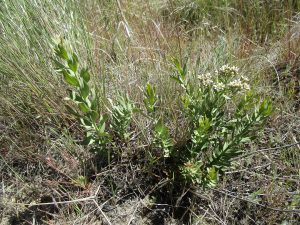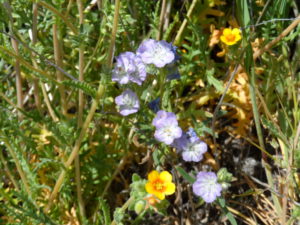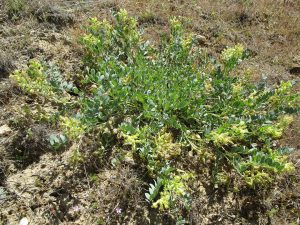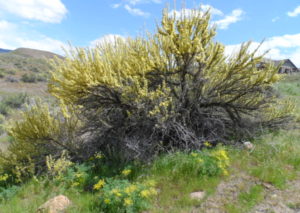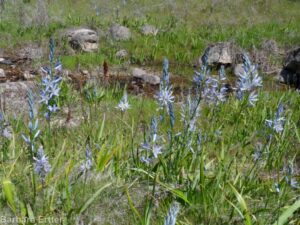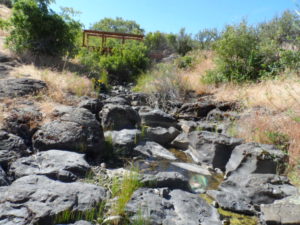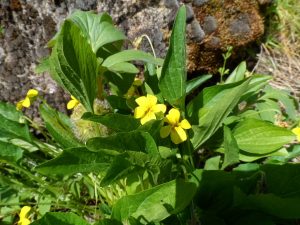RED TAIL/CURRANT CREEK WILDFLOWER WALK — early May
Description: This is a moderate walk (2 to 2.5 miles roundtrip,~300 foot total elevation gain) at the north edge of the Hidden Springs community,with highlights being the primary (or only) populations of camas, Tolmie’s onion, and freckled milkvetch in the Boise Front. Much of the trail is heavy clay,so avoid when wet. This works well as an evening walk, especially as the daytime temperatures are heating up.
From the Dry Creek Road trailhead (on the south side of Dry Creek Road between Cartwright Road and Seamans Gulch Road),cross the road and follow the path that doubles back up the southwest-facing slope. Note the heavy clay soil of this slope,in contrast to the sandy soils that are more common in the Foothills. Most of our native wildflowers are not adapted to this soil type,so the slope is relatively bare or weedy,but there is a large population of an unusual onion as the path curves around to a northwest-facing slope. This is the only known locality for Tolmie’s onion (Allium tolmiei) in the Boise Front, additionally noteworthy in that our plants do not quite “fit” the existing descriptions of the recognized varieties.
The northwest-facing slope itself is a good example of relatively intact sagebrush-steppe habitat,with a nice selection of wildflowers. The common dandelion-like plant is sagebrush false-dandelion (Nothocalais troximoides); the leaves differ from similar plants in having undulating,untoothed margins. Another interesting plant is more noteworthy for its unusual common name than its flowers: bastard toadflax (Comandra umbellata ssp. pallida),a distant relative of sandalwood.
Continue following Red Tail Trail as it doubles back to the east,recrossing both the northwest- and southwest-facing slopes. This part of the slope is much sandier than lower down,and the wildflowers are accordingly also different. Keep an eye out for distinctive native annuals,such as whitestem blazingstar (Mentzelia albicaulis) and threadleaf phacelia (Phacelia linearis). The lovely tufted evening-primrose (Oenothera cespitosa ssp. marginata) is scattered along the path (flowers closed midday),as is the only known population of freckled milkvetch (Astragalus lentiginosus var. chartaceus) in the Boise Front.
If you are lucky enough to catch the longspur or “polychrome” lupine (Lupinus arbustus) and arrowleaf balsamroot (Balsamorhiza sagittata) in bloom,you might wish to make a short side trip to the amazing display at the beginning of Bitterbrush Trail. Otherwise (or afterwards) continue north on Red Tail Trail,crossing the residential Deerpath and Sage Creek drives,and dropping down to Currant Creek. You are now on clay soils derived from volcanic rocks,with occasional outcrops of basalt. Bitterbrush (Purshia tridentata) is abundant here,as is butterfly biscuitroot (Lomatium papilioniferum) with its feathery,cilantro-scented leaves. Until very recently,butterfly biscuitroot was included in Gray’s biscuitroot (Lomatium grayii),until someone noticed that swallowtail butterflies would use one,but not the other,as a larval host plant. Subsequent molecular research confirmed what the butterflies already knew: that the two similar-looking plants are different species. Only butterfly biscuitroot occurs in this part of Idaho.
The special plant along the creek is the common camas (Camassia quamash). Scattered plants can also be found elsewhere on Currant Creek and Daniel Creek,but this by far the largest and most accessible population of this lovely wildflower. Although edible,please do NOT dig any up; there are too few for the number of people who might want to do the same,so leave them for everyone to enjoy. As with so many species in the Boise Front,our plants do not quite fit the existing descriptions of currently recognized varieties,and the leaves are a bit broader than elsewhere.
Depending on your timing and inclination,you can either retrace your steps to the trailhead,or alternatively follow the path west along the north side of tree-lined Currant Creek,crossing the bridge over a wonderfully sculpted basalt stream bed,and returning via the south side of Lookout Loop. Among the more interesting creekside plants that are likely to be in bloom in May are starry Solomon’s-seal (Maianthemum stellatum) and upland yellow violet (Viola praemorsa).
PLANT LIST [needs updating]
NOTE: Please enjoy the wildflowers and leave them for others to enjoy. Because our unique local flora is already under pressure from invasive weeds and habitat loss, harvesting of native plants is not encouraged on this website, especially along popular trails.
Plants are listed within categories in likely order of occurrence from trailhead; some might not yet be in bloom,or present during a particular year. * indicates native species
WILDFLOWERS
- *Stork- or cranesbill,filaree (Erodium cicutarium)
- *Cleavers,bedstraw,stickywilly,goose-grass (Galium aparine)
- *Western hawksbeard (Crepis occidentalis)
- *Fiddleneck (Amsinckia spp.) – species difficult to distinguish
- *Hareleaf (Lagophylla ramosissima)
- *Tolmie’s onion (Allium tolmiei; variety uncertain) – large colony here,but unknown elsewhere in Boise Front
- *Hermit milkvetch (Astragalus eremiticus)
- *Longleaf phlox (Phlox longifolia) intergrading with more compact *Pricklyleaf phlox (Phlox aculeata),
- *Yarrow (Achillea millefolium)
- *Arrowleaf balsamroot (Balsamorhiza sagittata)
- *Sagebrush false-dandelion (Nothocalais troximoides,previously in Microseris) – similar species without entire or ripple-margined leaves bloom later
- *Narrowleaf biscuitroot (Lomatium simplex, previously included in L. triternatum,nine-leaf biscuitroot)
- *Gray-green thistle (Cirsium cymosum var. canovirens) – the only locally native thistle
- *Barestem biscuitroot,pestle-parsnip (Lomatium nudicaule)
- *Longspur plectritis,Wedding-cake plant (Plectritis macrocera)
- *Spreading wallflower (Erysimum repandum) – non-native annual
- *Bastard toadflax (Comandra umbellata ssp. pallida)
- *Woolly-pod milkvetch (Astragalus purshii var. glareosus)
- *Eyelashweed or blepharipappus (Blepharipappus scaber)
- *Threadleaf phacelia (Phacelia linearis)
- *Desert alyssum (Alyssum desertorum) and/or pale alyssum (Alyssum alyssoides) – widespread non-natives,difficult to tell apart; also called madwort
- *Whitestem mentzelia or blazingstar (Mentzelia albicaulis)
- *Tufted or desert evening-primrose (Oenothera cespitosa ssp. marginata)
- *Freckled or broadleaf milkvetch (Astragalus lentiginosus var. chartaceus) – not known from elsewhere in the Boise Foothills
- *Lewis’s flax (Linum lewisii) – native to Idaho,but most (all?) populations in Boise foothills result from post-fire seeding
- *Longspur or polychrome lupine (Lupinus arbustus [= L. laxiflorus in older references])
- *Small or garden burnet (Sanguisorba minor,alternatively Poterium sanguisorba) – non-native,frequently included in post-fire seeding mixes for livestock and wildlife forage
- *Butterfly biscuitroot (Lomatium papilioniferum; previously included in L. grayii)
- *Common camas (Camassia quamash)
- *Wild-hyacinth,large-flowered triteleia,or Douglas’s brodiaea (Triteleia grandiflora,previously Brodiaea douglasii)
NOXIOUS AND/OR INVASIVE WEEDS (not all in bloom)
- *Cheatgrass (Bromus tectorum) — other annual Bromus also present
- *Mouse or wall barley (Hordeum murinum)
- *Blue mustard (Chorispora tenella)
- *Flixweed,Herb Sophia(Descurainia sophia)
- *Bulbous bluegrass (Poa bulbosa)
- *Feral or Cereal Rye (Secale cereale)
- *Perfoliate pennycress (Microthlaspi perfoliatum)
- *Whitetop (Lepidium [previously Cardaria] draba)
- *Rush skeletonweed (Chondrilla juncea)
- *Tumble or Jim Hill mustard (Sisymbrium altissimum)
- *Poison hemlock (Conium maculatum)
- *Medusahead grass (Taeniatherum/Elymus caput-medusae)
- *Moth mullein (Verbascum blattaria)
- *Clasping pepperweed (Lepidium perfoliatum)
- *Prickly lettuce (Lactuca serriola)
- *Yellow salsify or goat’s-beard (Tragopogon dubius)
- *Common dandelion (Taraxacum officinale)
- *Rattail fescue (Vulpia/Festuca myuros)
SHRUBS AND TREES (mostly not in bloom)
- *Basin big sagebrush (Artemisia tridentata subsp. tridentata)
- *Rubber rabbitbrush (Ericameria [formerly Chrysothamnus] nauseosa)
- *Bitterbrush,Antelope brush (Purshia tridentata)
- *Golden currant (Ribes aureum)
- *Netleaf hackberry (Celtis reticulata)
- *Dog rose (Rosa canina) – non-native,invasive in some spots
- *Black cottonwood (Populus trichocarpa) – other species and/or hybrids possibly present
- *Syringa,Lewis’s mockorange(Philadelphus lewisii)
- *Willows (Salix spp.) – several species locally,most are difficult to distinguish
PRIMARY BUNCHGRASSES (mostly not in bloom,but evident)
- *Squirreltail grass (Elymus elymoides,previously Sitanion hystrix)
- *Threeawn grass (Aristida purpurea var. longiseta)
- *Intermediate wheatgrass (Thinopyrum intermedium,alternatively in Elytrigia or Elymus)
- *Sandberg bluegrass (Poa secunda)
- *Bluebunch wheatgrass (Pseudoroegneria spicata,alternatively in Agropyron or Elymus) ) – both native-to-site and planted races from other sites probably present
- *Sheep fescue (Festuca ovina) – local populations probably all intentionally introduced
- *Great Basin wildrye (Leymus cinereus,previously in Elymus)
- *Crested wheatgrass (Agropyron cristatum) – widely planted non-native
OPTIONAL RETURN VIS CURRANT CREEK AND LOOKOUT LOOP (not all in bloom)
- *Silver or western mugwort (Artemisia ludoviciana var. ludoviciana)
- *Baltic rush (Juncus balticus)
- *Starry Solomon’s-seal (Maianthemum/Smilacina stellata)
- *Western poison-ivy (Toxicodendron rydbergii, alternatively Rhus radicans) – CAUSES DERMATITIS
- *Interior or Wood’s rose (Rosa woodsii subsp. ultramontana) – native,with slender prickles
- *Black hawthorn (Crataegus douglasii)
- *Black locust (Robinia pseudoacacia) – non-native tree
- *Goldenrod (Solidago sp.) – fall-blooming,species difficult to distinguish
- *St. Johnswort,Klamathweed(Hypericum perforatum) – invasive non-native,not in bloom
- *Himalayan blackberry (Rubus armeniacus/discolor/procerus) – tasty but invasive non-native
- various unidentified grasses
- *Mullein (Verbascum thapsus) – non-native,not in bloom
- *Western virgin’s-bower (Clematis ligusticifolia) – vine; not in bloom
- *Cherry plum (Prunus cerasifera) – non-native tree
- *Velvetweed or small-flowered gaura (Oenothera curtiflora,previously Gaura parviflora or G. mollis) – not native to Boise foothills,possibly in post-fire seeding; not in bloom
- *Chicory (Cichorium intybus)
- *Smooth scouring-rush (Equisetum laevigatum)
- *Povertyweed (Iva axillaris) – might not be in bloom
- *Nuttall’s or slender cinquefoil(Potentilla gracilis var. fastigiata) – might not be in bloom
- *Canary,Nuttall’s,or upland yellow violet (Viola praemorsa,alternatively a variety of V. nuttallii)
- *Common miner’s lettuce (Claytonia/Montia perfoliata,possibly other species as well)
- *American vetch (Vicia americana) – probably not yet in bloom
- *Oregon checkermallow (Sidalcea oregana) – probably not yet in bloom
- *Sandbar willow (Salix exigua)
- *Ballhead waterleaf,woolly-breeches (Hydrophyllum capitatum)
- *Foothill death-camas (Toxicoscordion/Zigadenus paniculatum)
- *Western or intermediate dogbane (Apocynum floribundum) – not in bloom
- *Tapertip onion (Allium acuminatum)
- *Dustymaiden or Bride’s-bouquet (Chaenactis douglasii)

